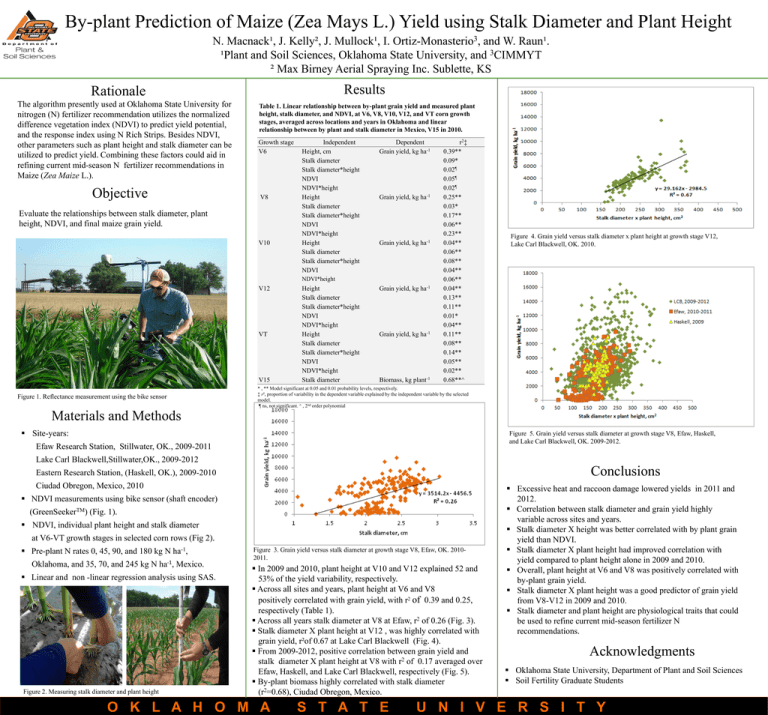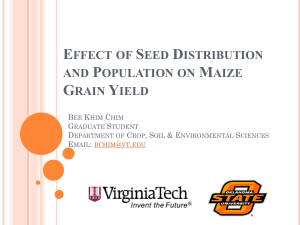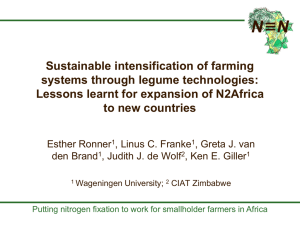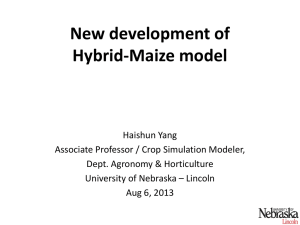Table 1. Linear relationship between by
advertisement

By-plant Prediction of Maize (Zea Mays L.) Yield using Stalk Diameter and Plant Height 3 Ortiz-Monasterio , N. Macnack¹, J. Kelly², J. Mullock¹, I. and W. Raun¹. 3 ¹Plant and Soil Sciences, Oklahoma State University, and CIMMYT ² Max Birney Aerial Spraying Inc. Sublette, KS Results Rationale The algorithm presently used at Oklahoma State University for nitrogen (N) fertilizer recommendation utilizes the normalized difference vegetation index (NDVI) to predict yield potential, and the response index using N Rich Strips. Besides NDVI, other parameters such as plant height and stalk diameter can be utilized to predict yield. Combining these factors could aid in refining current mid-season N fertilizer recommendations in Maize (Zea Maize L.). Objective Table 1. Linear relationship between by-plant grain yield and measured plant height, stalk diameter, and NDVI, at V6, V8, V10, V12, and VT corn growth stages, averaged across locations and years in Oklahoma and linear relationship between by plant and stalk diameter in Mexico, V15 in 2010. Growth stage V6 V8 Evaluate the relationships between stalk diameter, plant height, NDVI, and final maize grain yield. V10 Independent Height, cm Stalk diameter Stalk diameter*height NDVI NDVI*height Height Stalk diameter Stalk diameter*height NDVI NDVI*height Height Stalk diameter Stalk diameter*height NDVI Dependent Grain yield, kg ha-1 Grain yield, kg ha-1 Grain yield, kg ha-1 NDVI*height V12 VT V15 Figure 1. Reflectance measurement using the bike sensor Height Stalk diameter Stalk diameter*height NDVI NDVI*height Height Stalk diameter Stalk diameter*height NDVI NDVI*height Stalk diameter Grain yield, kg ha-1 Grain yield, kg ha-1 Biomass, kg plant-1 r2‡ 0.39** 0.09* 0.02¶ 0.05¶ 0.02¶ 0.25** 0.03* 0.17** 0.06** 0.23** 0.04** 0.06** 0.08** 0.04** 0.06** 0.04** 0.13** 0.11** 0.01* 0.04** 0.11** 0.08** 0.14** 0.05** 0.02** 0.68**^ Figure 4. Grain yield versus stalk diameter x plant height at growth stage V12, Lake Carl Blackwell, OK. 2010. * , ** Model significant at 0.05 and 0.01 probability levels, respectively. ‡ r², proportion of variability in the dependent variable explained by the independent variable by the selected model. ¶ ns, not significant. ^ , 2nd order polynomial Materials and Methods Site-years: Figure 5. Grain yield versus stalk diameter at growth stage V8, Efaw, Haskell, and Lake Carl Blackwell, OK. 2009-2012. Efaw Research Station, Stillwater, OK., 2009-2011 Lake Carl Blackwell,Stillwater,OK., 2009-2012 Conclusions Eastern Research Station, (Haskell, OK.), 2009-2010 Ciudad Obregon, Mexico, 2010 NDVI measurements using bike sensor (shaft encoder) (GreenSeekerTM) (Fig. 1). NDVI, individual plant height and stalk diameter at V6-VT growth stages in selected corn rows (Fig 2). Pre-plant N rates 0, 45, 90, and 180 kg N ha-1, Oklahoma, and 35, 70, and 245 kg N ha-1, Mexico. Linear and non -linear regression analysis using SAS. Figure 2. Measuring stalk diameter and plant height Figure 3. Grain yield versus stalk diameter at growth stage V8, Efaw, OK. 20102011. In 2009 and 2010, plant height at V10 and V12 explained 52 and 53% of the yield variability, respectively. Across all sites and years, plant height at V6 and V8 positively correlated with grain yield, with r2 of 0.39 and 0.25, respectively (Table 1). Across all years stalk diameter at V8 at Efaw, r2 of 0.26 (Fig. 3). Stalk diameter X plant height at V12 , was highly correlated with grain yield, r²of 0.67 at Lake Carl Blackwell (Fig. 4). From 2009-2012, positive correlation between grain yield and stalk diameter X plant height at V8 with r2 of 0.17 averaged over Efaw, Haskell, and Lake Carl Blackwell, respectively (Fig. 5). By-plant biomass highly correlated with stalk diameter (r2=0.68), Ciudad Obregon, Mexico. O K L A H O M A S T A T E Excessive heat and raccoon damage lowered yields in 2011 and 2012. Correlation between stalk diameter and grain yield highly variable across sites and years. Stalk diameter X height was better correlated with by plant grain yield than NDVI. Stalk diameter X plant height had improved correlation with yield compared to plant height alone in 2009 and 2010. Overall, plant height at V6 and V8 was positively correlated with by-plant grain yield. Stalk diameter X plant height was a good predictor of grain yield from V8-V12 in 2009 and 2010. Stalk diameter and plant height are physiological traits that could be used to refine current mid-season fertilizer N recommendations. Acknowledgments Oklahoma State University, Department of Plant and Soil Sciences Soil Fertility Graduate Students U N I V E R S I T Y









